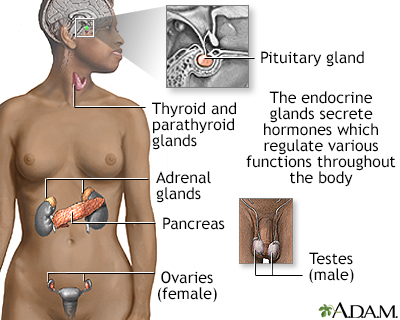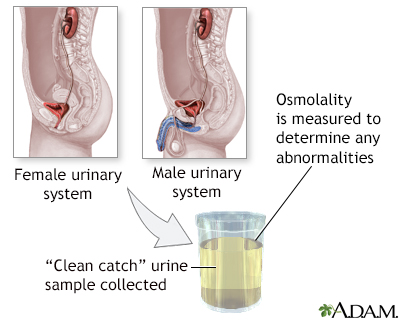Diabetes insipidus
Diabetes insipidus (DI) is an uncommon condition in which the kidneys are unable to prevent the excretion of water.
DI is not the same as diabetes mellitus types 1 and 2. However, untreated, both DI and diabetes mellitus cause constant thirst and frequent urination. People with diabetes mellitus have high blood sugar (glucose). Those with DI have normal blood sugar levels, but their kidneys are not able to balance fluid and salt in the body.
Images


I Would Like to Learn About:
Causes
During the day, your kidneys filter all your blood many times. Normally, most of the water is reabsorbed, and only a small amount of concentrated urine, relative to the volume of blood, is excreted. DI occurs when your kidneys cannot concentrate the urine normally, and a large amount of dilute urine is excreted.
The amount of water excreted in the urine is controlled by antidiuretic hormone (ADH). ADH is also called vasopressin. ADH is produced in a part of the brain called the hypothalamus. It is then stored and released from the pituitary gland. This is a small gland just below the base of the brain.
DI caused by a lack of ADH is called central diabetes insipidus. When DI is caused by a failure of the kidneys to respond to ADH, the condition is called nephrogenic diabetes insipidus. Nephrogenic means related to the kidney.
Central DI is rare. It can be caused by damage to the hypothalamus or pituitary gland as a result of:
- Genetic problems
- Head injury (common cause)
- Infection in the brain
- Problem with the ADH-producing cells due to an autoimmune disease
- Loss of blood supply to the pituitary gland
- Surgery in the area of the pituitary gland or hypothalamus (most common cause)
- Tumors in or near the pituitary gland
Nephrogenic DI involves a defect in the kidneys. As a result, the kidneys do not respond to ADH. Nephrogenic DI is very rare. Nephrogenic DI may be caused by:
- Certain medicines, such as lithium
- Genetic problems
- High level of calcium in the body (hypercalcemia)
- Kidney disease, such as polycystic kidney disease
Symptoms
Symptoms of DI include:
- Excessive thirst that may be intense or uncontrollable, usually with the need to drink large amounts of water or craving for ice water
- Excessive urine volume
- Excessive urination, often needing to urinate every hour throughout the day and night
- Very dilute, pale urine
Exams and Tests
Your health care provider will ask about your medical history and symptoms.
Tests that may be ordered include:
- Blood sodium and osmolality
- Desmopressin (DDAVP) challenge
- MRI of the head
- Serum co-peptin level
- Urinalysis
- Urine concentration and osmolality
- Urine output
Your provider may have you see a doctor who specializes in pituitary diseases to help diagnose DI.
Treatment
The cause of the underlying condition will be treated when possible.
Central DI may be controlled with vasopressin (desmopressin, DDAVP). You may take vasopressin as an injection, a nasal spray, or tablets.
If nephrogenic DI is caused by a medicine, stopping the medicine may help restore normal kidney function. But after many years of use of some medicines, such as lithium, nephrogenic DI can be permanent.
Hereditary nephrogenic DI and lithium-induced nephrogenic DI are treated by drinking enough fluids to match urine output. Medicines that lower urine output also need to be taken.
Nephrogenic DI is treated with anti-inflammatory medicines and diuretics (water pills).
Outlook (Prognosis)
The outcome depends on the underlying disorder. If treated, DI does not cause severe problems or result in early death.
Possible Complications
If your body's thirst control is normal and you are able to drink enough fluids, there are no significant effects on body fluid or salt balance.
Not drinking enough fluids can lead to dehydration and electrolyte imbalance, which can be very dangerous.
If DI is treated with vasopressin and your body's thirst control is not normal, drinking more fluids than your body needs can also cause a dangerous electrolyte imbalance.
When to Contact a Medical Professional
Contact your provider if you develop symptoms of DI.
If you have DI, contact your provider if frequent urination or extreme thirst returns after treatment.
Related Information
Antidiuretic hormone blood testPolycystic kidney disease
Dehydration
Sodium blood test
Pulse - bounding
Weight loss - unintentional
Electrolytes
Fatigue
Muscle aches
References
Thompson CJ, Garrah A. Disorders of sodium, diabetes insipidus and hyponatremia. In: Robertson RP, ed. DeGroot's Endocrinology. 8th ed. Philadelphia, PA: Elsevier; 2023:chap 12.
Verbalis JG. Disorders of water balance. In: Yu ASL, Chertow GM, Luyckx VA, Marsden PA, Skorecki K, Taal MW, eds. Brenner and Rector's The Kidney. 11th ed. Philadelphia, PA: Elsevier; 2020:chap 15.
BACK TO TOPReview Date: 5/12/2023
Reviewed By: Sandeep K. Dhaliwal, MD, board-certified in Diabetes, Endocrinology, and Metabolism, Springfield, VA. Also reviewed by David C. Dugdale, MD, Medical Director, Brenda Conaway, Editorial Director, and the A.D.A.M. Editorial team.

Health Content Provider
06/01/2025
|
A.D.A.M., Inc. is accredited by URAC, for Health Content Provider (www.urac.org). URAC's accreditation program is an independent audit to verify that A.D.A.M. follows rigorous standards of quality and accountability. A.D.A.M. is among the first to achieve this important distinction for online health information and services. Learn more about A.D.A.M.'s editorial policy, editorial process and privacy policy. A.D.A.M. is also a founding member of Hi-Ethics. This site complied with the HONcode standard for trustworthy health information from 1995 to 2022, after which HON (Health On the Net, a not-for-profit organization that promoted transparent and reliable health information online) was discontinued. |
The information provided herein should not be used during any medical emergency or for the diagnosis or treatment of any medical condition. A licensed medical professional should be consulted for diagnosis and treatment of any and all medical conditions. Links to other sites are provided for information only -- they do not constitute endorsements of those other sites. © 1997- 2025 A.D.A.M., a business unit of Ebix, Inc. Any duplication or distribution of the information contained herein is strictly prohibited.
